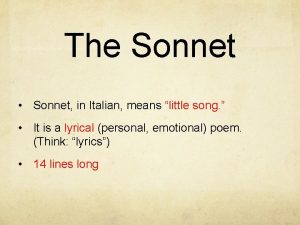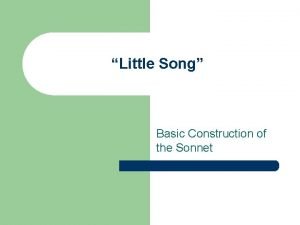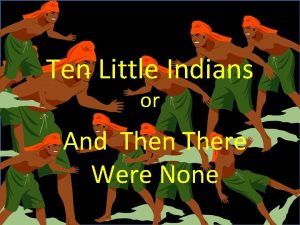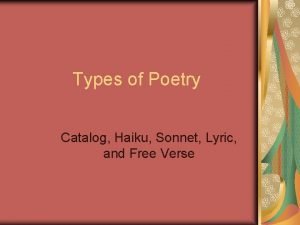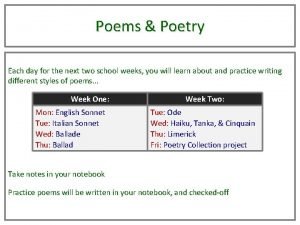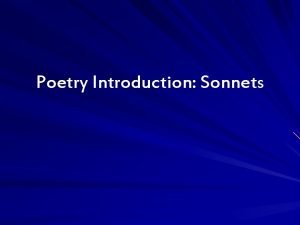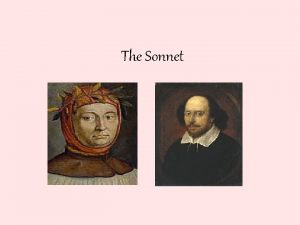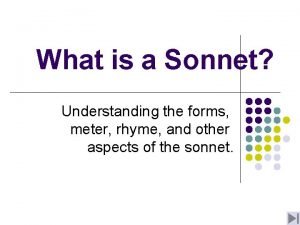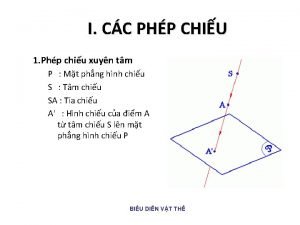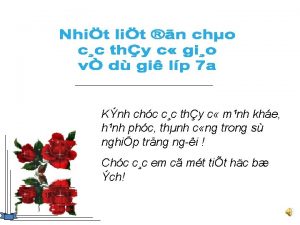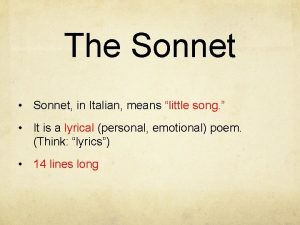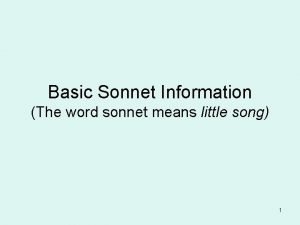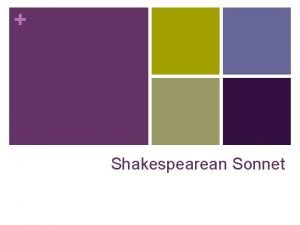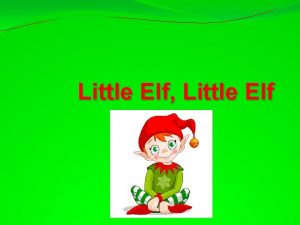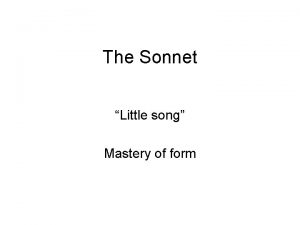The Sonnet Sonnet in Italian means little song



















- Slides: 19

The Sonnet • Sonnet, in Italian, means “little song. ” • It is a lyrical (personal, emotional) poem. (Think: “lyrics”) • 14 lines long

Francesco Petrarch • Original sonnet form = Italian, Petrarchan sonnet or • Petrarch (1304 -1374): sonnets made up of octave (8 lines) + sestet (6 lines) • Used rhyme scheme: abba cde • A “volta, ” or turn, launches the sestet • His sonnets are often about unrequited love. (Had the hots for “Laura. ”)


Petrarch’s Sonnet 134 (Translated from the Italian by Anthony Mortimer) I find no peace, and have no arms for war, and fear and hope, and burn and yet I freeze, and fly to heaven, lying on earth's floor, and nothing hold, and all the world I seize. My jailer opens not, nor locks the door, nor binds me to hear, nor will loose my ties; Love kills me not, nor breaks the chains I wear, nor wants me living, nor will grant me ease. I have no tongue, and shout; eyeless, I see; I long to perish, and I beg for aid; I love another, and myself I hate. Weeping I laugh, I feed on misery, by death and life so equally dismayed: for you, my lady, am I in this state.

Page from Petrarch’s Canzoniere, 1464. Sept. 2004, Yale University Beinecke Rare Book and Manuscript Library.

Sonnets Come to England • English poets Thomas Wyatt (hot for Anne Boleyn!) and Henry Howard translated some of Petrarch’s sonnets into English in the 1520 s and 1530 s. • By the 1580 s, sonnets had become extremely popular on the Continent (i. e. not England) • Sir Philip Sidney’s Astrophil and Stella (1591) started a craze for the sonnet in England.

Front page of Sidney’s Astrophil and Stella, 1591. <http: //www. shakespeares-sonnets. com/Astro 1. htm>

William Shakespeare portrait collage from: www. sonoma. edu/users/b/babula/homepage. htm

The REAL Shakespeare? The “Cobbe” portrait, identified in 2009 as the only existing life portrait of Shakespeare. [The Shakespeare Birthplace Trust]

• Born: 1564, Died: 1616 (on his birthday perhaps: April 23) • Besides being a prolific playwright, he wrote 154 sonnets (+ 2 longer mythological narrative poems). • Collection of sonnets published in 1609 under puzzling circumstances, by a fairly sleazy printer Thomas Thorpe. Unlikely that Shakespeare authorized their publication. • The sonnets did not receive much attention for many years.

Front page of Shakespeare’s Sonnets. Thomas Thorpe, 1609. <http: //www. wsu. edu/~delahoyd/shakespeare/sonnets. html>.

How and why did he write them?

• The editors of the Folger Shakespeare Library edition of his sonnets explain: • “Almost all of them love poems, the sonnets philosophize, celebrate, attack, plead, and express pain, longing, and despair, all in a tone of voice that rarely rises above a reflective murmur, all spoken as if in an inner monologue or dialogue. ”

Organization • The sonnets are usually grouped together. • The first set (Sonnets 1 -17): addressed to a “Young Man. ” • The second set (Sonnets 18 -126): celebrate the poet’s love for the man, and also address jealousy, longing and pain. • The third set (Sonnets 127 -154): involve a woman—known as the “Dark Lady. ”

Left: Shakespeare’s Dark Lady by Ian Wilson. <www. shakespearesdarklady. com> Right: William Herbert, 3 rd Earl of Pembroke by George Vertue. National Portrait Gallery. <http: //www. npg. org. uk>

Shakespearean Sonnet • INNOVATION! Shakespeare reinvents the existing Petrarchan sonnet form. • Also 14 lines. Rhyme scheme: abab, cdcd, efef, gg • Couplet at the end = distinguishing feature. • Meter: iambic pentameter (10 syllables per line) • Shakespeare’s style: inversion (“Goes he” instead of “He goes”), metaphors and metrical effects. • INNOVATION! Subject matter is not just unrequited love.

Structure • Three quatrains (4 lines each) + a couplet (2 lines). (4 + 4 + 2) • Each quatrain develops a specific, related idea • The couplet finishes the idea. • COUPLET– WHAT DOES IT DO? “The couplet may be a logical conclusion, a further thought, or even a dramatic denial of what has come before” (Broadview Anthology 122).

Works Cited and Consulted • Black, Joseph, ed. et al. The Renaissance and the Early Seventeenth Century. Broadview Anthology of British Literature. Peterborough, Ont: Broadview P, 2006. • Mowat, Barbara A. and Paul Werstine, eds. Shakespeare's Sonnets. Washington, D. C. : Folger Shakespeare Library, 2004. 14 Oct. 2007. <www. folger. edu/template. cfm? cid=926>. • Shapiro, James. 1599: A Year in the Life of William Shakespeare. NY: Harper Collins, 2005.

Sonnet 18 Shall I compare thee to a summer's day? Thou art more lovely and more temperate: Rough winds do shake the darling buds of May, And summer's lease hath all too short a date: Sometime too hot the eye of heaven shines, And often is his gold complexion dimmed, And every fair from fair sometime declines, By chance, or nature's changing course untrimmed: But thy eternal summer shall not fade, Nor lose possession of that fair thou ow'st, Nor shall death brag thou wand'rest in his shade, When in eternal lines to time thou grow'st, So long as men can breathe or eyes can see, So long lives this, and this gives life to thee.
 Petrarch sonnet 134
Petrarch sonnet 134 Means little song in italian
Means little song in italian Sonnet little song
Sonnet little song Khi nào hổ mẹ dạy hổ con săn mồi
Khi nào hổ mẹ dạy hổ con săn mồi Khi nào hổ mẹ dạy hổ con săn mồi
Khi nào hổ mẹ dạy hổ con săn mồi 1 little 2 little 3 little indian
1 little 2 little 3 little indian 1 little 2 little 3 little indian
1 little 2 little 3 little indian Catalog poem examples
Catalog poem examples Sonnet english and italian
Sonnet english and italian What is the structure of an italian sonnet?
What is the structure of an italian sonnet? How to write an ode template
How to write an ode template Italian or petrarchan sonnet
Italian or petrarchan sonnet Petrarch sonnet 159
Petrarch sonnet 159 Sonnet 130 tpcastt
Sonnet 130 tpcastt Italian sonnet by james deford
Italian sonnet by james deford What makes a song a song
What makes a song a song Giọng song song là gì?
Giọng song song là gì? Phép chiếu song song
Phép chiếu song song Cách chứng minh hai đường thẳng song song
Cách chứng minh hai đường thẳng song song In tr
In tr
